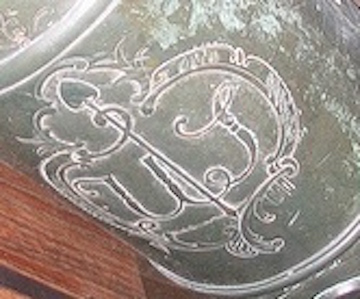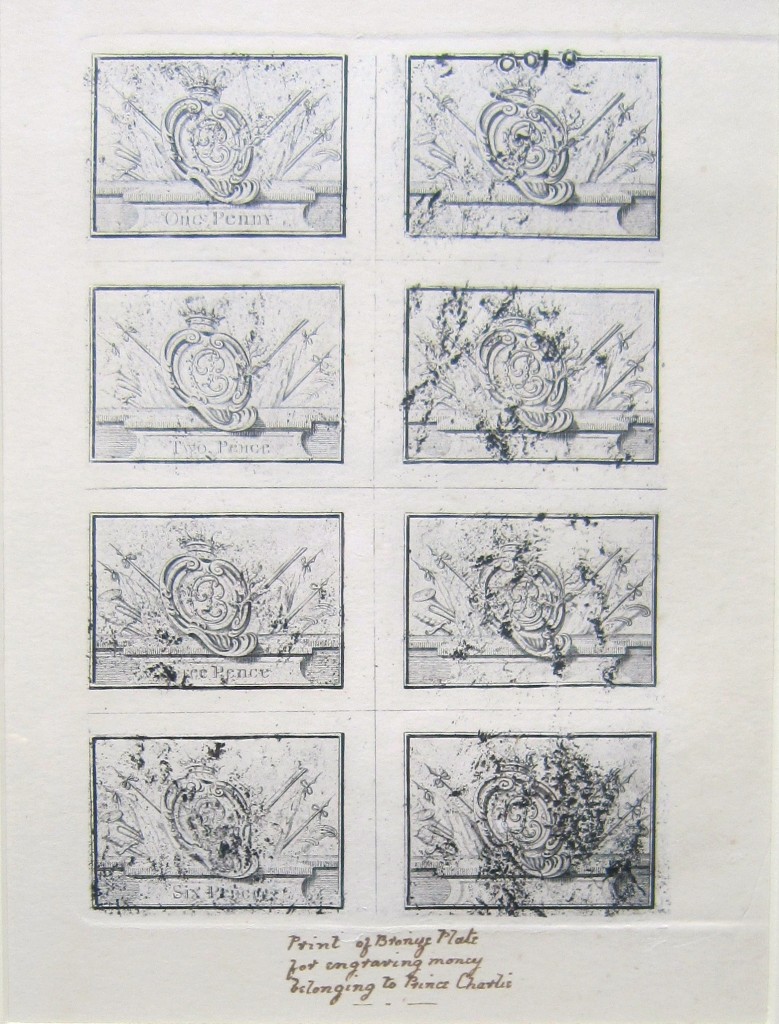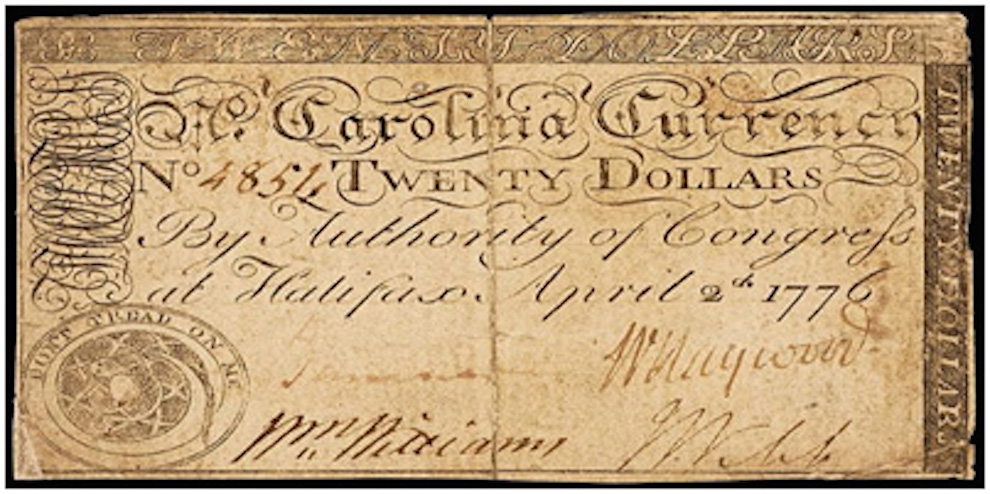************* ************* *************
I would like to thank Gary Gianotti for his invaluable help in my early educational years. He was able to provide our work with enough insight and information into the Scottish Royal Culture which helped us tie concrete evidence into Dale and I theory of an Enlightened Council of Revolutionaries who operated behind the scenes of the states political statesman. —Robert J. Silverstein
************* *************
Sir Robert Strange
1721-1792
*************

************* ************* *************
************* *************
The 1745 Bonnie Prince Charlie
Bronze Money Plate
*************
This is a paper impression showing Sire Robert Strange’s Scrolling Art Work.
************* ************* *************
~ Transformational Scrolling Art Technique ~
Using Strange’s bronze engraved money plate we are going to tie-in a broad spectrum of American art that was created by Robert Scot and his Philadelphia Artisans. The point of this article is to show how Robert Scot used Sir Robert Strange’s signature Scrolling Art technique and then transformed it over time for use in Allusions in New Federal American Insignia. Using this transformative scrolling technique, Robert Scot’s Artisans were able to apply it to a broad spectrum of commissioned projects. This would include everything from authoritative seals, maps, flags, and other state official document items.
Pictured above is the bronze money plates which were originally engraved by Sir Robert Strange for Scotland’s Bonnie Prince Charlie. Before the young pretender sailed to Scotland and raised the Jacobite standard in Glenfinnan he needed a way to fund his war. So, Prince Edward Stuart had copper money plates engraved by Sir Robert Strange with the intent of paying the Clansmen of the Highlands a commission to fight for his Jacobite Army. Sir Robert Strange was instructed to engrave nominal Pence designs since victory was uncertain. The Bonnie prince completely understood that the money plates would only be needed if by fortune he was granted victory. This way the survivors of his Jacobite army could be paid for their services, and he would also be able to print nominal sums when needed across the countryside. I believe he saw the prints off these money plates as an I.O.U. or even a check which could be redeemed a a later date.
All we know for certain, is that sometime after the battle in 1745, when Prince Edward Stuart was on the run from the British soldiers between Inverness and the moors of Culloden he instructed that the money plates be tossed into a pond before they were able to flee to France.
With the understanding of the reasoning behind the fabrication engraving of the money plates we can know focus our attention on the Signature Scrolling Art of Sir Robert Strange. We believe that this style of scrolling art was most likely developed as an anti-counterfeit currency technique. The artistry designs themselves would have to provide a Scottish heraldry, and religious authority in-order provide sanctioned sovereignty and value. By infusing the designs with these authoritative sanctions, Sir Robert Strange’s scrolling art can be viewed as an authoritative copyright to the House of Stuart, and a legal deterred for other artisans not to copy or use this scrolling artwork design.
Since the Bonnie Prince was in the process of restoring the House of Stuart from the dethronement of King James II, one can reasonably conclude that Sir Robert Strange’s scrolling art work never became formally accepted or formally recognized as being a true copyright for the House of Stuart. Since the Battle of Culloden went unfavorably for the Young Pretender, any money printed off these plates would be worthless. The only way for these plates and their designs to receive authority would be if the exiled Prince was able to regain the British throne hereby making it actual legal tender. Prince Edward Stuart must have had the foresight that these engraved copper needed an authoritative design which would be needed in his efforts to establish his regained authority of Kingship.
Unfortunately, Prince Edward Stuart lost the war and any real hope at the Battle of Culloden in 1745. This defeat automatically voided-out any predetermined copyright claim Sir Robert Strange would have to the scrolling artwork created for the House of Stuart. Without a prior copyright, it allowed Sir Robert Strange’s student Robert Scot to re-transform it 30 years later when he went to America as an anti-counterfeit currency plate engraver in the southern colonies. Robert Scot based his new transformational designs using Sir Robert Strange’s scrolling art work tecnique. As the years progressed into a Revolutionary state in America, Scot would adapt this anti-currency Scrolling art once again into a signature Monogram Snake Art with a Beaded Cypher design. I personally like to reference this unknown style as, “The Transformational Worm & Snake Scrolling.” I haven’t figured out what the Beaded Cypher Number Pattern represents at this point, but i can reasonably explore the avenue that it is an Allusion which would grant some kind of heraldry, authority stemming from the House of Stuart. From cross-matching other artisan engravings umbrella’d under or from Robert Scot we can see it used in a number of artisan pieces over his lifetime. From early American George Washington Inaugurals to later English King & Constitution Buttons. (Figure A.1: GWI 21 & GWI 22 Figure: A.1)
************* ************* *************
Figure A.1: 1789 GWI 21 With Scrolling Art & Beaded Cypher
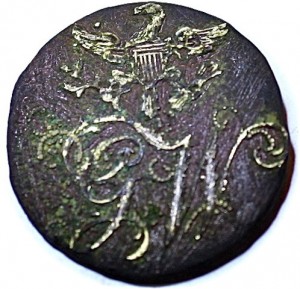
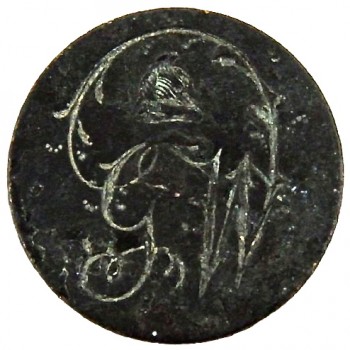
************* *************
Figure A.2: 1790’s King & Constitution W/ Beaded Cypher.
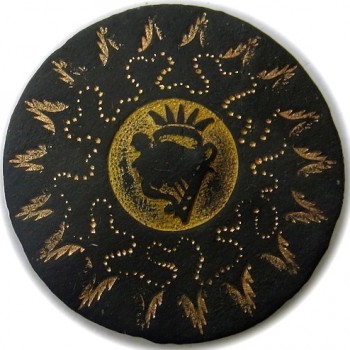
Defining The Allusion’s True Intended Meanings:
In the late 1780’s and through the 1790’s, the Council of Enlightened Revolutionaries were directing Congressional Committees to award commissions to Artisans who were either known too, or directly operating under Robert Scot’s guild umbrella. As the chessboard pieces are moved into place by the Enlightened Revolutionaries, certain artisans were chosen who were known to have heraldry knowledge and religious background education. Using defined parameter’s of the heritage of the Scottish Royal Culture these multi-nationality artisans were able to furnish the pre-requesits needed as an Allusion. The new federal insignia was one of many chessboard piece moves that would ensure that America’s standing on the world’s stage would be safeguarded regardless of the direction the New Republic went in the distant future. As an underlying objective, the Council of Revolutionaries knew which ever way the New Republic went in governance, the natural resources of the land needed recognized divine authority with impunity rights of other country leaders. Meaning, who is the natural heir to provide the right of sovereignty on the World’s stage.
Thinking strategically, the council of enlighten men would have provided a framework for the artisans that would reflect necessities like, Majestic Authority, Religious Heraldry, and have a Pre-eminent Official Stature associated with all Sovereign Nations in their official documents. This symbolism acts as a prestigious representation of the power and faith behind the agreements which exemplifies the trust needed for our federal government to function to promote it’s interests.
For researcher’s interests in discovering a starting point into Robert Scot’s transformational scrolling art, we must first start with the break down of his teacher Sir Robert Strange’s scroll work in the 1745, copper money plate engravings. In the engraving of the one penny and two pence (Fig A.3), we can clearly see the scrolling art work forms an official Crest like representation of symbols which reflect an underlying authoritative nature reinforced by historical symbology. Breaking it down into several factors needed to present sanctioned authority for Pince Edward Stuart.
So, first let us look at the religious representation within the art. There are three tubular off-shoots on the bottom of the scroll work which i believe represents, Jesus Christ, and his connection to the Worm. This depiction of the worm religious meaning grants the Crest a religious authority by the way of Christianity. Next, is the Regnal Crown of Scotland which is surmounting the scrolling art work. This provides the connection between the authority of the House of Stuart and ordained religious authority granted by God. This Royal Crest symbol provides automatic ordained authority which cannot be questioned by their subjects. To even dig a little deeper, this style of artistry is how Sir Robert Strange in-directly connects the Royal bloodline families of Scotland with in-direct authority. Hence, granting power to family bloodline members for political or economic governance. So, one can conclude that Sir Robert Strange’s Scrolling Art work is a representation of Ancient Scottish Royal Culture and religion which enables authority and heraldry these Artisan techniques would be the foundation for Robert Scot’s 1780’s & 1790’s federal insignia, state seals, and even private aristocrats personal items such as Maps and so forth.
Figure A.3: Robert Strange’s Engraving of One Penny / Two Pence
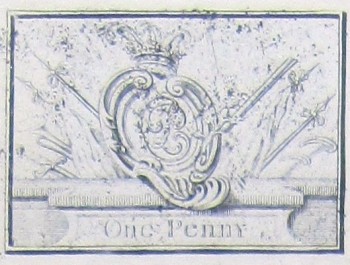 *
* 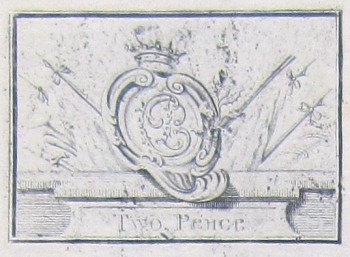
I believe that Robert Scot used Strange’s ideas because America needed new insignia that gave heraldry and religious Authority.
Draft 1 jan 2018
Robert Scot’s Transformational Worm & Snake Scrolling Art
Lets look at several types of earlier American engraved objects that are documented as Robert Scot artwork. First, we should begin with his earliest known artwork in colonial currency (Fig.B-1) In this state backed note we can see that he uses the same scrolling techniques that was taught to him by his old teacher Sir Robert Strange. These are very similar techniques that can be reflected from the 1745, Bonnie Prince money plates. One can certainly conclude that he bought this authoritative scrolling technique to America for his own use in anti-counterfeit techniques on currency notes.
Figure B.1: Currency Note Engraving by Robert Scot.
Colonel John Proctor’s 1st Battalion Westmoreland County Pennsylvania militia flag is another perfect example of how Robert Scot transforms his scrolling art technique to reflect earlier family ties in ancient history with other European Royals to the Scottish Royal family bloodlines. In this flag, we found hundreds of embossed or impressed symbols in the fabric which I believe detail this history which grants it’s Royal authority. We know that some of these fabric symbols are stone mason symbols which are a reflection of the Scottish Royal family history, and their associations with 12th Century Cathedrals they built and supported. One can say this can give it it’s religious authority. There is also subcutaneous symbols pressed into the fabric like the letter, “E” (which is the Latin symbol for God). which most likely denote to the (Order) Knights of St. John and it’s Royal interwoven marriage history. Here again these symbols grants historical Royal authority by bloodlines. Please look for a full account of symbolism in my Do Not Tread On Me Flag section.
In this article, we are just going to focus on Robert Scot’s scrolling artwork which covers an earlier time period with the Normans and Viking conquerors. If we look at the top left hand side of the flag, we can see how he conforms the scrolling art design to depict a Dragon which represents the Germanic Norse Seafarers. (Fig B-2). He probably did this to give the flag (or Scottish Royals) an earlier authority from history. We should also note that the Norman’s conquest of England was in 1066. In the 10th century, these Normans were descended from the earlier feudal Vikings who were given overlordships in areas of northern France- the Dutchy of Normandy. We also know that two Vikings even ascended to the throne of England between 1013-1035. So, this can be viewed as the Scottish Royal family marriage ties with the earlier Vikings / Normans. This would most likely date from the 8th to the 11th centuries. On the right-hand-side, Robert Scot transformed his scrolling art work to represent and tie-in the earlier Pictish Snake history.
Figure B-2: Scrolling Art Tribute to Vikings & Pictish People
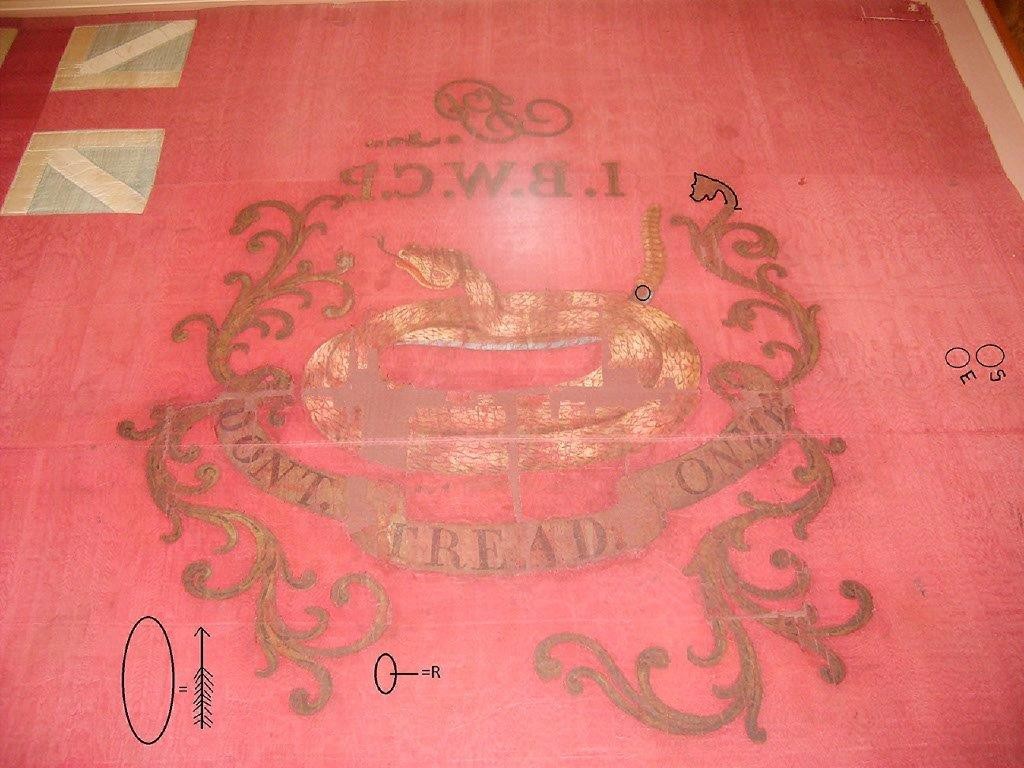
Photograph Illustrations by Dale Hawley.
In the Lawrence Washington Seal we see how Robert Scot transformed his signature Scrolling Art into a Monogram Art for noted individuals. Here again he cleverly infuses this Scrolling Monogram Art with religious and cultural history. First, we see the Christianity reflection of Jesus and his reference to the Worm. This could grant the seal a religious authority. Second, he transformed some of the Scrolls into Serpent Snakes to give reference to the ancient Pictish Snake history (Fig C-3).
Figure C-3: The Lawrence Washington Seal: Photograph by RJ Silverstein.
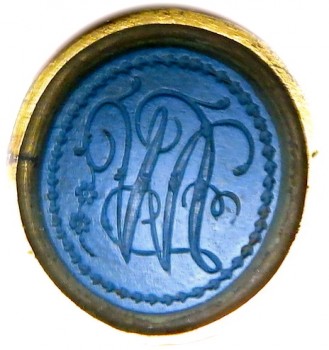
The last example I am going to show of Robert Scot’s Transformational Scrolling Art is on the burial cannon of William Augustus Washington (Fig 4). Even though James Byers of Philadelphia made the cannon, it was Robert Scot who engraved the shield with his Scrolling Artwork. In this shield Robert Scot combine the era’s accomplishments of William Washington with ancient cultural history. We see the newly founded U.S. government monogram and it’s surrounding crest with his signature style scrolling. This gives it the religious and historical representation. Next we have the Phrygian Cap and Liberty Pole to represent W. Washington’s struggle for freedom. This art can be taken from the Romans or the Bonnie Price’s propaganda’s use.
What makes this cannon shield’s engraving very special is that he combined his Scrolling Artwork with a Special Beaded Cypher Pattern Design. This rare seen beaded design is a representation of a secret cypher that has relation to a number pattern. Obviously, this holds a special significance and meaning to certain onlookers. We do know that Freemasons of that era used numbered patterns which held significance and meaning, but at this point I am at a loss as to deciphering it.
Figure 4. William A. Washington’s Burial Cannon
